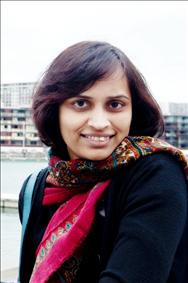 As August-September arrives people in Maharashtra prepare themselves for the popular and much awaited Ganapati festival.
As August-September arrives people in Maharashtra prepare themselves for the popular and much awaited Ganapati festival.
Ganesh Chaturthi is the birthday of Lord Ganesha. It falls on the fourth day of the bright fortnight of Bhadrapada and is observed by devoted Hindus all over the world from two to 11 days. This festival day this year is on September 19.
Hindus believe the elephant-headed God, known as the ‘Remover of Obstacles’ and ‘God of Power and Wisdom,’ is the eldest son of Lord Shiva and Goddess Parvati. Every religious festival, be it a simple prayer at home or a grand yagna at a temple, begins with a submission to Lord Ganesh.
Maharashtrians, like their Hindu compatriots worldwide, induct their children into learning with ‘Om Sri Ganeshaya Namaha.’
Several Names
Ganesha is known by a variety of names including Aumkara, Balachandra, Dhoomraketu, Ekadantha, Gajakarnaka, Gajanana, Heramba, Kapila, Lambodara, Siddhivinayaka, Skandapurvaja, Sumukha, Surpakarna, Vakratunda, Vignaraja, Vigneshwara and Vinayaka. He is also known by many as Maha-Ganapathi.
The Ganesh festival begins with fervor as the idol is brought home for worship and a few days later, immersed in water.
Smaller idols, in various sizes and colours would be on sale in every street corner in Maharashtra. From ‘pocket size’ to 10 metre high, Ganesh idols are a source of joy and occupy a place of pride at home, with the idiom, ‘Ganapati Bappa Moraya.’
Children usually compete with each other in decorating the place.
The Pooja
The Ganesh pooja involves the panchamrut or ‘five nectars,’ including milk, curd, ghee, honey and jaggery, with which the idol is bathed. He is then soiled with sandal paste and cleaned with water.
The Lord is then adorned by a red cloth called, ‘vastra’ and the sacred thread. He is offered red flowers, ‘durva’ (grass), red hibiscus and food and smeared with ‘kumkum.’ A lamp is lit and pooja bells ring while reciting ‘arati’.
The main sweet-dish presented as ‘nevedya’ through this period is modakas (modagams in South India) and karanjis. A modaka is like a dumpling made from rice flour with a stuffing of fresh coconut, jaggery and dry fruits and is either steam-cooked or fried. Karanjis are half-moon shaped and taste like modakas.
On the last day, following the pooja, rice grains are placed on the head of the idol.
At sunset, the idol is immersed in a well or a river, with the recitation of ‘Ganapati Bappa Moraya, pudchya varshi lawkar ya,’ inviting Him to return next year.
There are also public celebrations called ‘Sarvajanik Ganeshotsav’ of this festival in various parts of cities, with the local communities (mandals) with contributions from residents. It is common for groups to compete in creating the biggest and best idol and in presenting cultural programmes after dusk.
Radical nationalist Bal Gangadhar Tilak organised Ganesh Utsav in 1893 and since then, the festival is held throughout Maharashtra, evincing widespread community interest.
Sai Badekar is a regular reader of Indian Newslink. She lives in Auckland






